The original idea was simple. At a faculty meeting devoted to ideas for theatre projects that could be safely accomplished at Northwestern University in the face of the Covid-19 pandemic, director Dassia N. Posner proposed a puppet performance. Posner and a team of volunteers would build a flock of white birds to fly down the lakeshore on campus. Her puppetry performance aimed to create community in a time of distance and scarcity. The proposed public spectacle would allow Posner to share the creation process with a wide circle of collaborators, including other puppeteers, designers, directors, performers, and makers on campus. The simple scene was also packed with metaphorical potential – the flock in white was peaceful, mournful, and joyful all at once. In the first of many serendipitous complications, department chair Rives Collins went a step further when he evoked the image of the mythical phoenix. When co-director Jessica Thebus joined the project, she and Posner expanded the event to include a narrative arc based on Collins’ suggestion: flocks of birds would gather, be transformed in a mystical fire, and fly away renewed. As it evolved, the Flight of the Phoenix would continue to spiral upward and outward––rising, like its mythical namesake, from the ashes of a difficult year.
While the performance was being created, the campus was still locked in a strange stasis. In-person gathering was only possible if participants honoured social distancing protocols and masking mandates. The theatre department began to experiment with puppetry to render that forced distance artful – shadow puppets wielded by a single set of hands made a whole cast of characters for a children’s theatre adaptation of The Jungle Book, unmasked hand puppets became expressive extensions of their masked puppeteers in Tomás and the Library Lady, and––finally––the giant bird puppets in Flight of the Phoenix took the performance outside, into the open air. At a time when the theatre department could not deliberately invite any audience to gather on campus, outdoor puppets allowed the performance to capture the attention of an unsuspecting public. It was also agreed early on that the finished performance would be captured on film by Yun Lin and Maximo Grano de Oro (Master of Fine Arts), working with editor Quinn Kelch, to safely expand the audience for the performance by including online viewers. Relying on happenstance in public spaces and streaming performances for an unseen audience placed a renewed emphasis on the joy of making theatre that is often eclipsed by the focus on presenting it to the public. The puppets became conduits for cooperation that brought a community of makers back together to work as a team after an extended period of isolation.
As self-proclaimed puppet people, Posner and Thebus were prepared to watch their initial idea continue to transform. Puppets can be famously uncooperative in the face of pre-determined directorial concepts. Instead, it is best to be prepared for a de-centralized creative process that allows construction to determine action. Jim Lasko—theatre maker, puppeteer, and former artistic director of Redmoon Theater Company in Chicago—ponders what he calls “radical listening” in “The Third Thing” (2014). Lasko addresses the series of “concentric circles” that form around a puppet or performing object. He states: “In the center sits the artist or artists who initiate the conversation; then moving outward in widening spheres are the groups of interlocutors: artists, collaborators, the formal properties of a given site; and then finally the social situation” (Lasco 2014, 103). Flight of the Phoenix arguably followed the same expansive pattern, beginning with Posner and Thebus as the artists at the centre. Moving into conversation with the MFA designers, the directorial duo added a second circle of collaborators with new ideas. Nora Marlow Smith—who became the so-called “bird captain”—and her fellow MFA designers Kaitlyn Landry and Daphne Agosin Orellana brought in their love of the local and migratory birds that populate the lakefront. Now the real and the mythical could coexist, beginning by reminding audience members of the wonder that is always part of their world. Visually, the white palette in the original idea expanded to include a range of neutral blues, browns, and grays. At first glance, the birds would be a natural, if outsized, part of their environment, making the explosion of their fantastical “fire colours” even more dramatic.
For all the birds to transform into phoenixes, the artistic team had to find a way to create “fire.” They began by exploring ideas in production meetings that would adorn the lake-front park with drapery, lights, and archways—architecture that would direct attention to a faux-fire at the centre of the clearing. The team initially imagined the bird puppets bobbing and swooping through the flames that would transform them. Yet fire is, fundamentally, a mobile source of light. Eventually, the fire evolved into a “living” being, a fire wyrm, a wingless, armless subspecies of benevolent dragon drawn from Norse Mythology. The fire wyrm for the Flight of the Phoenix was designed by Joe Johnson and Maximo Grano de Oro and created by myself and fellow puppeteer and Ana Díaz Barriga (PhD). The glowing fire wyrm would serve as the catalyst for the birds’ metamorphosis. It was accompanied by a colour-guard of fire banners whose bearers, led by Erin Claeys, could run swiftly among the birds in each flock to cue their transformation. With each step, the performance continued to become bigger and more convoluted.
Each large-scale bird, created by an MFA designer, would be accompanied by a pod of smaller birds built by additional volunteers from the broader university community. The theatre staff worked together to support the build while honouring personal boundaries and the university’s Covid protocols, guided by production manager Heather Basarab. The scene shop—including Matt Buettner, Shannon Perry, Dylan Jost, and Chris Wych—constructed bodies for twenty-five birds in five different colour palettes while assembling “take home” kits that allowed students to build and decorate the birds’ papier mâché heads. The finished bird heads were heavy enough to anchor the puppet’s light bodies, made of fabric streamers, as they fluttered in the breeze. The fabric part of the bodies, made in the costume shop under the guidance of Marina Arconti, were rigged to “burst into flame.” The scene shop staff’s ingenious mechanism, fashioned from binder clips, released streamers in bright red, orange, yellow, gold, and purple over the original feathered body of each bird. Students then built their bird heads and returned them to the shop to be paired with a body. Posner made a series of how-to videos and held papier mâché sessions online, via Zoom, for those working from home in their apartments and dorm rooms. The ability to separate the act of making from the act of puppeteering and to decentralize where the build would happen meant that more students could be involved while still honouring their own limitations during the ongoing pandemic. The massive scene shop space also allowed those who wanted to gather in person to keep an appropriate social distance. During bird-building events, students at all levels, from undergraduate freshmen to doctoral students, gathered around long, communal tables set out in the sunshine to build “small” birds.
The inspiration for the birds’ construction came from the directors’ previous experience with different puppetry companies, drawing on both Posner’s work with the Puppeteers’ Cooperative and Thebus’s ongoing work with The Persephone Project. Posner learned her giant puppet creation techniques from working with Sara Peattie of the Puppeteers’ Cooperative, where she spent years leading giant puppet building workshops in local communities and creating puppets for Boston’s annual New Year’s Eve First Night parades. Jessica Thebus has long collaborated with members of Redmoon, and the same Bread and Puppet influence that inspired the Flight of the Phoenix is also present in her ongoing work with The Persephone Project, including their contributions to Extinction Rebellion protests, and the outdoor events she collaboratively staged on the Chicago lakefront as part of The Art of Spontaneous Spectacle during the pandemic. Both directors have also worked directly with Bread and Puppet, and their respective companies share Bread and Puppet roots that connect them to a long-standing tradition of political papier mâché puppetry.[1]
In the mid-twentieth century Peter and Elka Schumann’s company, Bread and Puppet, began building large-scale papier mâché puppets for protests in New York City before migrating to the Northeast Kingdom of Vermont, where they continue to create politically relevant puppet performances that tour both nationally and internationally. The company’s deliberate emphasis on simple materials has allowed them to continuously operate outside formal funding structures and maintain their political edge by living communally, making do with flour-based paste and cheap paint, and scavenging building supplies from recycled paper and scrap wood to discarded cardboard.[2] Puppetry scholar John Bell called Bread and Puppet’s working methods “an economical and practical way to create spectacle theatre” (but it is important to note that the utility of those inexpensive, hands-on methods also has an ethical dimension. By relying on volunteers, Bread and Puppet “make(s) the theatre’s connections to the communities it [has] performed in essential through the integration of local community members into the performances” (Bell 2008, 196-197). Beyond the financial benefits of using similar, inexpensive but effective construction methods to build the puppets for Flight of the Phoenix, there is also a shared emphasis on building community through active participation.
The materials used to make the smaller birds were easy to obtain. Cardboard, paper, and paste formed the papier mâché heads while the bodies were made from polyester lining fabric secured to a wire form and raised up into the air by a bamboo pole. Díaz Barriga led Zoom workshops with international participants – giving advice on how to gather supplies so they too could tune in to the “how to” videos from far-flung locations and make their own birds. While birds took shape on campus in Evanston, they were also being made in Pittsburgh, Warsaw, and Seoul. By sending in footage of their finished bird in flight, those participating from a distance could be folded into the documentary film, and, thus, into the bourgeoning flock. The student body expanded the Northwestern across state lines and national borders by staying connected to the on-campus event. The simplicity of the design left space for all the puppet makers to contribute to the kind of multiplicity radical listening encourages, wherein “each voice changes the work itself, takes form, and develops and evokes the next set of iterations, which subsequently must also be heard” (Lasco 2014, 100). Each contributor could diversify the event by making their own positionality visible through the way they stylized their puppet. In the final performance, each bird was different: queer rainbow-coloured birds and multi-cultural birds, abstractly painted birds and identifiable wild species all flocked together.
The common task of working with the papier mâché became a bonding agent. If any puppet or performing object can become a mediator, as in Lasko’s theorization, humble papier mâché made of plain paper and paste is arguably an exceptionally useful intermediary. It is created from materials that are readily available, possibly even recycled in a best-case scenario, non-toxic, and simultaneously forgiving for new makers and capable of sculptural beauty in the hands of advanced artisans. The very structure of papier mâché, is described by Eleanor Margolies in her book Props as “a laminate–– a material made of layers glued together,” feels like a metaphor for finding strength in community as “[t]he layering of the material…makes the new material much stronger” (Margolies 2016, 110). As the layers of paper smooth out the rough contours of the cardboard structure underneath, they create exceedingly sturdy puppets. The ability to withstand rough handling, wind, and weather are instrumental to the projects’ continual expansion toward the finished spectacle as they are handed off to newly recruited puppeteers and taken out in public as part of the finished spectacle. Each bird—whether near or far, plain or fanciful—was bonded to its flock by their common material bodies.
Ongoing challenges were answered by an ever-widening circle of artists and craftspeople during the build. The small birds for each pod followed the same construction methods as the originally proposed flock, but the designs for the larger puppets required new techniques. The whole shop staff came together to seek solutions to questions: “How can we create equally light bodies for the large-scale birds in more complex shapes?” and “What combination of sculptural materials and electronic equipment can give the fire wyrm a portable, internal glow?” True to Lasko’s theorization of radical listening, the contributions of disparate collaborators coalesced around the physical objects in their hands as they followed the propensities of their materials toward the puppet’s final form. The designers and makers worked in shifts, taking turns occupying the same space to keep a safe distance. Yet they were never working in a vacuum: they built on the foundational labour of others, and they could see progress being made on the other puppets laid out on adjacent tables or propped up on makeshift stands fashioned from bamboo poles and traffic cones nearby. The final aesthetic for the whole performance was a product of a fruitful environment where the designers and makers drew inspiration from each other’s works in progress.
Ideas that began as scale models, made on kitchen tables and desktops in student apartments, became full-scale creations suited to an outdoor performance. The bigger birds of the lake-front—the kestrel, swallow, great blue heron, seagull, and goose—were many times the size of the smaller birds and took on their own distinct style as the MFA designers and shop staff found their way through a thicket of decisions about how each one should be made. The Heron, Swallow, and Kestrel became painterly, molded by designers Smith, Landry, and Orellana and daubed with paint by resident scenic artist Jim Weber until they resembled impressionist paintings. The simple features and bright-white body of the seagull, designed by Posner, made for the most dramatic transformation from feathers into flame. The head of the Canadian Goose, whose maker Kaitlyn Landry chose to bring this bird to life as a fellow Canadian citizen, became startlingly realistic instead, formed over a curved armature out of lighter, thinner layers of paper that created a smooth finish, with eyes that showed a natural highlight because they were made from repurposed Christmas bulbs that were incorporated into the head during the puppet’s construction. To match the distinctive style of each head, scene shop craftspeople helped to design bodies that were equally unique. In addition to the streamers that connected them to the smaller birds, these bodies were also defined by wind-sock like cylinders formed with wire and three-dimensional oval bodies formed with round reed, all covered with fabric that branched out into broad wings and long graceful necks.
The fire wyrm needed to be a distinctly different type of beast. The research called for it to be more lantern-like: able to show the lights within to full effect. I joined the team of makers, alongside Díaz Barriga to build the fire wyrm out of round reed and cover it with fabric. I learned to work with reed from Rough House Theater Company, a group of Chicago puppeteers who regularly offer workshops in addition to their congoing season of puppet performances.[3] Their method called for the pliable pre-soaked reed to be wrapped in cotton string, soaked in white glue, to hold it in place as it dried into its new shape. This method is comparatively eco-friendly, but not particularly fast. Díaz Barriga met me in the scene shop on my first day of construction to teach me her method, which she learned from teaching artist and puppeteer Anne Cubberly, of Hartford, Connecticut.[4] Díaz Barriga showed me how to use an internal armature made of cardboard, to facilitate a more complicated shape, and fasten the same round reed with zip ties and Gorilla Glue instead of string and paste, to form a stronger, faster bond. Together, we laid down the first of three layers of round reed to begin the fire wyrm’s construction. As with the papier mâché, this technique also brought with it another lineage of puppetry and more opportunities for teamwork during the creative process.
Once the round reed form within the head was complete, the next step was to cover it with fabric so that head and body would become a unified part of the total spectacle. To keep the fire wyrm linked to the rest of the performance’s visual vocabulary, it needed to echo the birds’ fiery red, orange, and yellow. The body was composed of long streamers of the same “fire coloured” fabric used for the birds’ transformation affixed to a double layer of net so that the final puppet was equal parts positive and negative space. The finished cylindrical “skin” of the wyrm was wrapped around wire hoops holding strings of battery-powered lights, installed by Peter Anderson and Mike Trudeau from the lighting department. The final touches were added by hand-sewing fabric and layers of trim to the primary skin, stretched over the cane form, and installing the eyes, made from faceted globes provided by Anderson to refract the lights shining within. As the puppet moved between makers across different departments it began, in Lasko’s words, to “reveal itself,” making its way through a series of compromises between idea and material reality toward its first flight (Lasko 2014, 98).
Once the puppets were complete, the next phase brought together teams of puppeteers to bring them to life. The birds flew in pods, with the small single-operator birds gathered around the goose, kestrel, seagull, heron, and swallow, all of which had three to five operators. The fire wyrm needed six dedicated puppeteers, plus additional standard bearers for the fire banners. The MFA directing students, Hamid Dehghani, Ismael Lara, Katie Lupica, and Tor Campbell, and faculty members Halena Kays and Shana Cooper joined the project to help create choreography for each team. Using warm-up exercises and drills, each group of puppeteers quickly learned to move together so that the body of their puppet followed the head, the wings stayed aligned, and the puppet’s gaze was filled with intention as its body was endowed with breath. Through trial and error, the teams discovered how their assigned puppet moved: turning the heron’s head at the end of its long neck, made of flexible fabric; flapping the seagull’s flowing wings; and shaking out the fire wyrm’s streamers. Working together, the directorial team found ways to link the most impactful movement vocabulary to the story of transformation. This step required a shift in mindset as the directors, faculty members, and puppeteers learned to shift their attention away from their fellow human beings and toward their puppets. The masks the puppeteers wore out of necessity as a Covid precaution ultimately served the performance by directing attention toward the visible face of each puppet. As Posner explained at the first rehearsal, fixing your eyes on the puppet, giving it your full attention, is, in some cultures, even believed to shift your soul into the puppet, so that as the puppet flies, you fly, too.
The path toward performance relied on a fundamental belief on the part of directors Posner and Thebus that “if we build them, they will come.” They had to trust that students would pick up their kits, complete them, and return them on time; that the completed puppets would find puppeteers, who were willing to put in the time to rehearse and perform; and that the performance would find an audience on the lakefront in fair weather, at a time when the world in general remained cloistered. They relied on the same “persistent combination of some of the most traditional elements of puppet theatre” that drives the work of Bread and Puppet, where, according to Bell, “the use of simple materials, direct means, and a strong connection to community” culminates in “a reflection and articulation of community conscience” (Bell 2008, 210). Building puppets and building community become synonymous acts. The final step is to perform for the public who, like the artistic team, are given license to shape the production as both viewers and interpreters of the performance.

To begin the pageant, each pod of birds assembled at a different location and processed to a small island off the eastern shore of the campus (see Figures 1-5). Once on the island, the flocks flowed towards an open clearing accompanied by the sound of wind chimes and a chorus of acoustic instruments, which included chair Rives Collins on guitar.
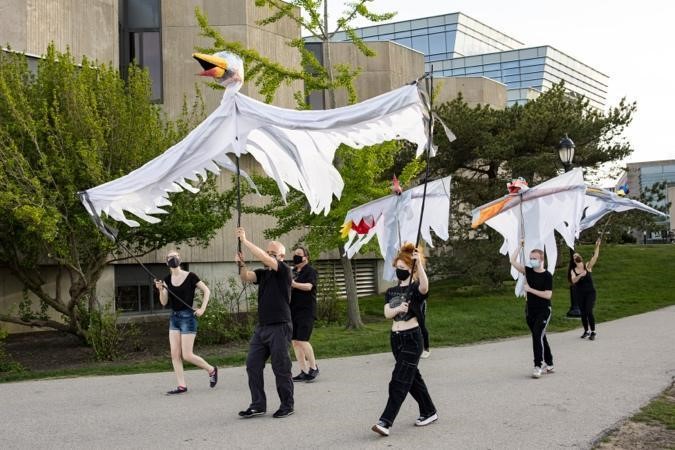
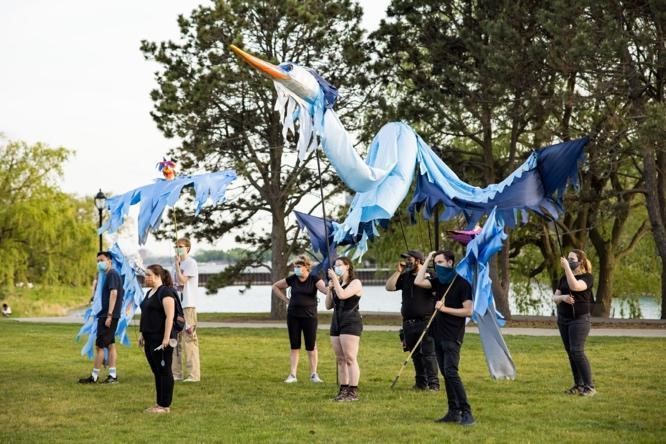
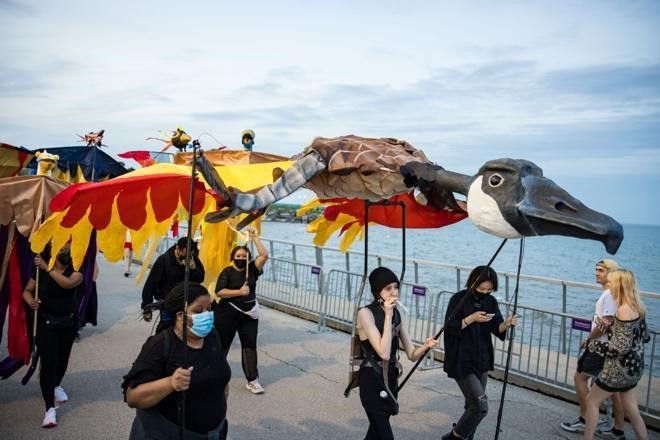

The fire wyrm took to the field first, circling in the centre while waiting for the birds to establish the outer perimeter of the circle. Once the birds arrived, the wyrm walked up to the first bird, the heron, and they bowed to each other (see Figure 6). The wyrm gave a mighty shake and snaked upward in a wave that moved from head to tail and from tail to head.

The fire wyrm threw off sparks—the banners of flame that danced among the birds in each pod. True to the story of the Phoenix, each bird burst into “flame” when a quick release sent a fluttering set of streamers tumbling over its wings, transforming the natural into the fantastical. The wyrm greeted each bird in turn: kestrel, swallow, seagull, and goose before it left the clearing (see Figures 7-9).
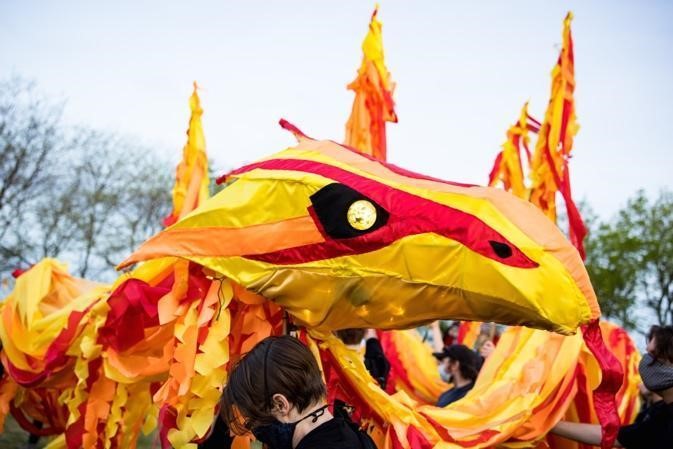
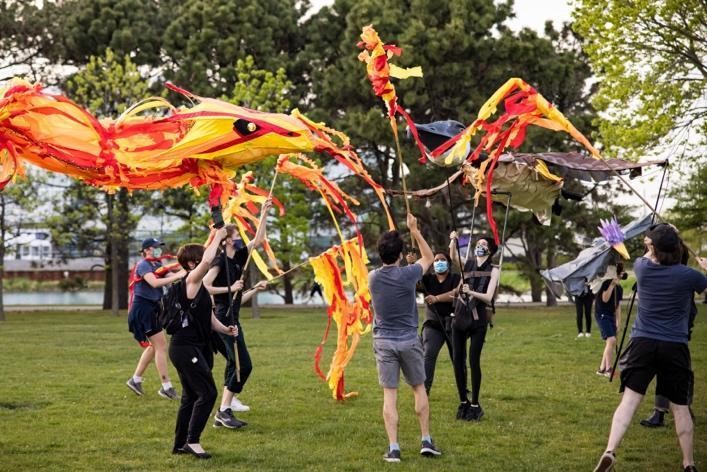
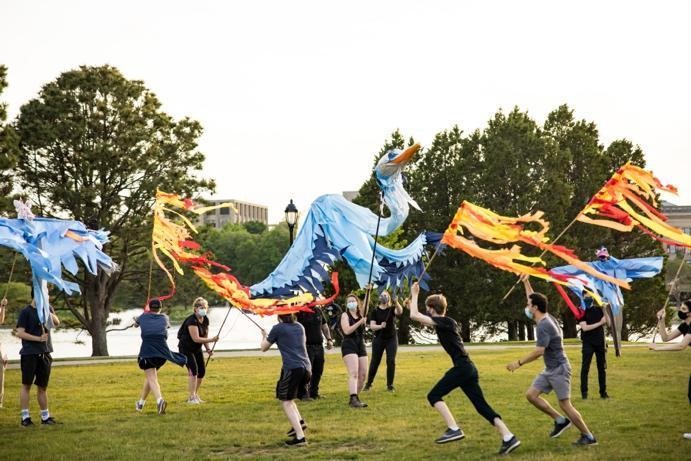
Renewed and joyful, the chorus of birds in their vibrant new fire-coloured plumage burst into song, joining in singing a variation on a traditional Appalachian spiritual, by Michael-Ellen Walden, that began with the repeated refrain: “Bright morning stars are a-rising” and ended in the hopeful declaration: “Day is a-breakin in my soul.” That refrain alternated with a series of choruses that each echoed through their own triumvirate repetitions:
We will rise from fire and ashes
The light of day’s a-callin
Reborn, we’ll soar together
Can you feel your soul awaken?
The song closed with a final refrain, calling on the dawn, before the birds wheeled off down the island and back across the lake, fanning out to circle around the lawn, and finally returning to roost in the scene shop (see Figures 10-11). After sundown, the fire wyrm made a final journey around the centre-lawn, at the heart of the campus, snaking through the trees as it glowed in the darkness.
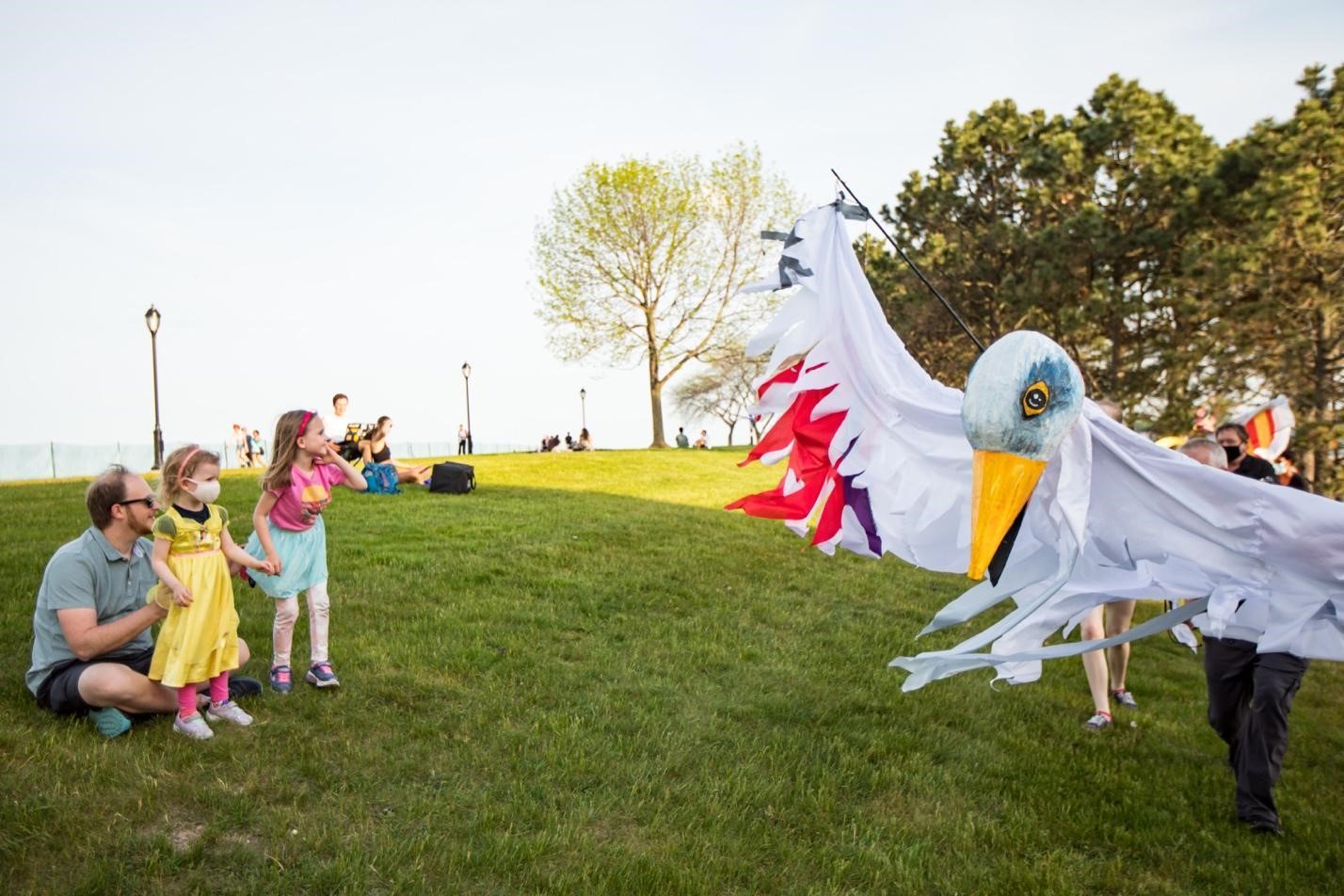
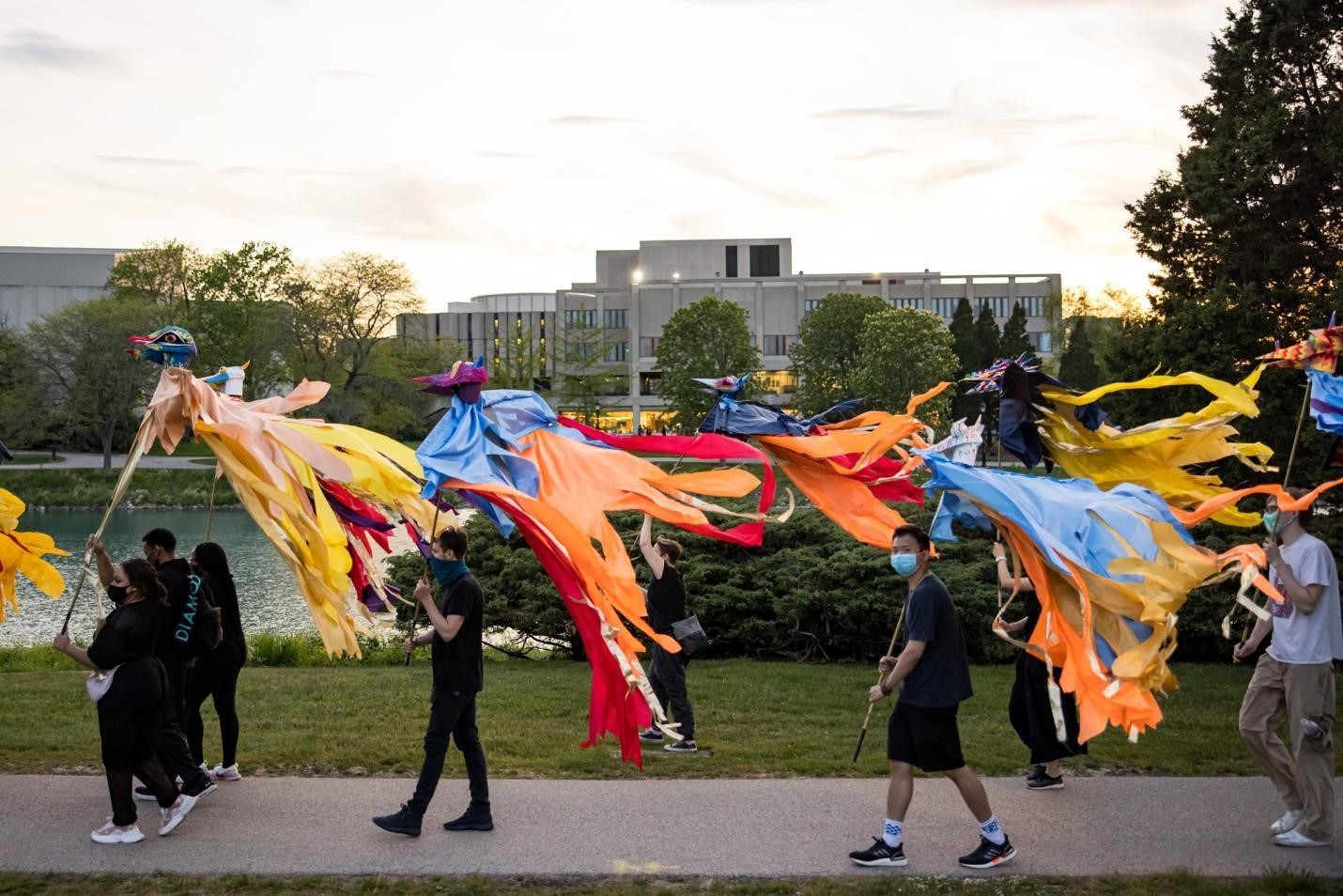
As the puppets paraded along the island, they greeted an unsuspecting audience, bobbing past college students who whipped out their cell phones to record, touching down to meet the outstretched hands of children running past, and slowly bending down their heavy heads to greet elderly members of the audience with respect. Performing crowned the proceeding acts of radical listening with a final, expansive circle by folding in an audience “who occupied that same public space, who had no intentional relationship to the event” when they set out to enjoy the lakefront, but who “witnessed,” according to Lasko, “the eruption of spontaneous community” around the spectacle (Lasko 2014, 102). While the audience online would see the puppet pageant unfold as edited, attending the physical performance added an additional layer to the experience. Both performers and audience could feel the warmth of the sun and the pull of the wind. Each audience member’s point of view depended on their vantage point. They could choose to come in close to see how the individual puppets were made or pull back to suspend disbelief in these magical creatures and better see the choreographed story arc. In the same way that the puppet makers were able to bring their varied perspectives to their work, the audience members were also able to craft individual experiences of the performance. For Lasko, the “spectacle,” the culminating public performance, ultimately “holds in lively tension each expanding circle of the conversation, ending with the sphere that includes all those witnessing it and the space around them” as it brings the audience into the creative fold (Lasco 2014, 103). The sheer scale of this kind of performance, the archetypal nature of its narrative, and its wordless grace allowed it to encompass a range of meanings for both artists and audience. At the circle’s widest point, this performance of Flight of the Phoenix simultaneously celebrated migration after a period of stasis, told a resurrection story that centred survival, and became a way to memorialize loss and begin to let go of grief.
The simplicity of the performance opens it up to myriad interpretations, and that flexibility is what will continue to give this project life long after the Covid-19 pandemic has ended. The hope is that this will become an annual event – celebrating the point in the year where new students are invited to campus as others graduate, marking a renewable moment of transformation for the university community. As a campus tradition, the performance can continue to grow and change. Every new group of students who come to participate in the messy joy of making will place their own mark on the performance by simultaneously adding another unique bird to the flock and becoming part of an ongoing story. If you would like to learn more about the project from the directors and see the full performance on video, visit https://www.youtube.com/watch?v=T7BsWkbTFy8.
BIBLIOGRAPHY
Barbin, Justin, Fire Wyrm, 2021, photograph, Justin Barbin Photography, Evanston.
_____________. Goose in Flight, 2021, photograph, Justin Barbin Photography, Evanston.
_____________. Goose Transformation, 2021, photograph, Justin Barbin Photography, Evanston.
_____________. Heron Flock, 2021, photograph, Justin Barbin Photography, Evanston.
_____________. Heron Transformation, 2021, photograph, Justin Barbin Photography, Evanston.
_____________. Kestrel in Flight, 2021, photograph, Justin Barbin Photography, Evanston.
_____________. Returning to Roost, 2021, photograph, Justin Barbin Photography, Evanston.
_____________. Seagull Flock, 2021, photograph, Justin Barbin Photography, Evanston.
_____________. Seagull Greets Family, 2021, photograph, Justin Barbin Photography, Evanston.
_____________. Swallow in Flight, 2021, photograph, Justin Barbin Photography, Evanston.
_____________. The Fire Wyrm Bows, 2021, photograph, Justin Barbin Photography, Evanston.
Bell, John. 2008. American Puppet Modernism: Essays on the Material World in Performance. New York, NY; Houndsmills, Basingstock, Hampshire: Palgrave Macmillan.
Estrin, Marc. 2010. “The Sustainable Energy of the Bread & Puppet Theater: Lessons Outside the Box.” The Radical Teacher, 89: 20-30, https://doi.org/10.5406/radicalteacher.89.0020
Lasko, Jim. 2014. “The Third Thing.” In The Routledge Companion to Puppetry and Material Performance, edited by Dassia N. Posner, Claudia Orenstein, and John Bell, 98-104. Abingdon, Oxon; New York, NY: Routledge.
Margolies, Eleanor. 2016. Props. London: Palgrave Macmillan Education.
NOTES
[1] Many thanks to Dassia N. Posner for contributing this paragraph on the performance’s puppet lineage.
[2] For more on Bread and Puppets from a company member, see Estrin 2010.
[3] For more on Rough House Theater Company, visit: https://www.roughhousetheater.com.
[4] For more on Cubberly, visit: https://www.annecubberly.com.